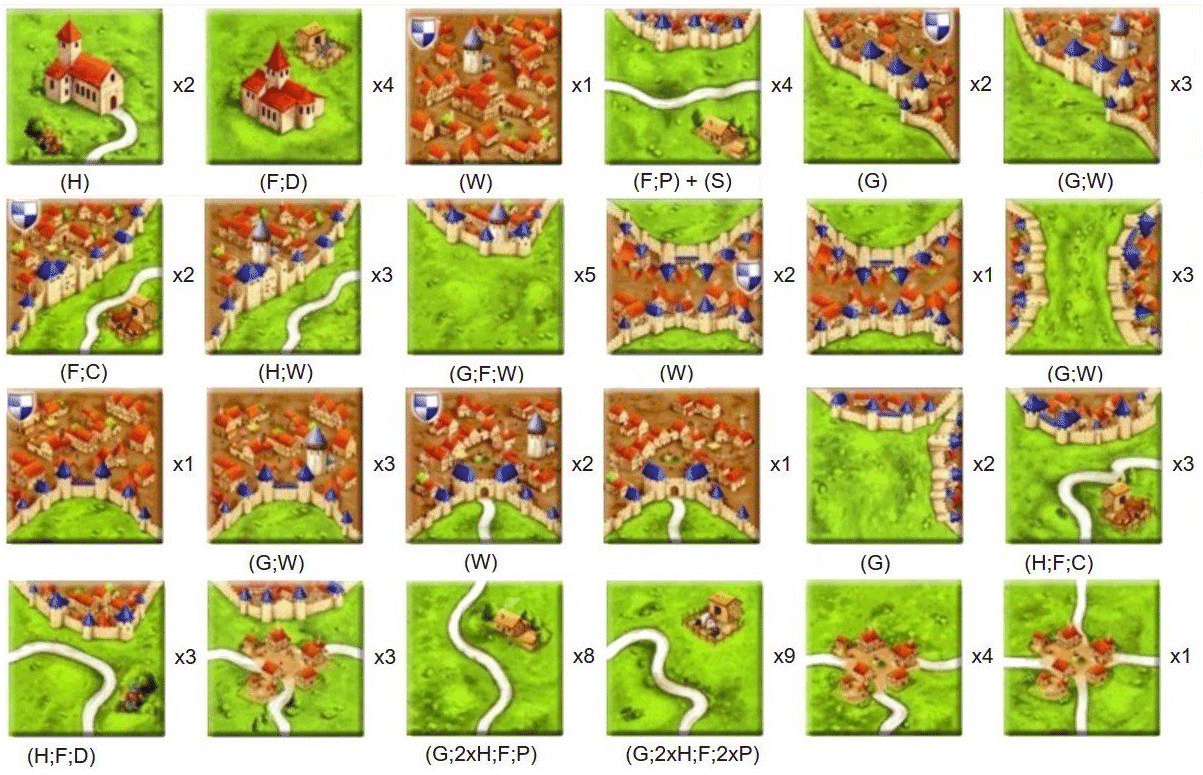Overview and goal of the game
In Carcassonne, players take turns placing random tiles and expanding
the landscape of roads, cities, monasteries and fields, one tile at a
time. Players may place their meeples on the individual features of
tiles as well (roads, cities, monasteries, and fields), where they
will become highwaymen, knights, monks and farmers. Points are earned
throughout the game, and the player with the highest score at the end
is the winner!

Carcassonne is a tile-based German board game for two to five players
that was first published in 2000. The English version is currently
published by Z-Man Games. It is named after the medieval fortified
town of Carcassonne in southern France, famed for its city walls.
The backs of all the tiles are the same, but the START TILE has a
darker colored back, so you can recognize it easily.
Place the start tile (the one with a dark back) in the middle of the
table. Shuffle the remaining tiles and set them as different facedown
stacks that are easily accessible to all players.
Then, the first player turns over one of the 71 random face down
tiles. The four sides of each tile can only be city, road, or field.
Each randomly drawn tile can be rotated in four different positions
to continue the landscape of the existing map. The first tile is
easy, only one edge of the new tile has to match one edge of the
existing tile, city to city, road to road, field to field. As the
game progresses, this gets more difficult when the placement of the
new tile might have to match two, or three, or four edges of the
tile(s) of the existing map.
After selecting their desired rotation and adding the new tile to
the map, the player then decides which of the landscape features
on the new tile they wish to control and places one of their
7 meeples on that feature on the tile they just placed.
Now it is the second players turn and they draw a Monastery tile which
can actually be placed in 5 different locations!
When the Monastery is completely surrounded by other tiles, it will be
worth 9 points. The position chosen for the Monastery already has 2 of
the 8 surrounding tile and Yellow want to place the third tile above it
to complete their city. But, placing the Monastery here has another
advantage: the tile necessary to complete the city is now more
difficult, because the rotation of that tile must now have two
matching sides, not just one!
The game continues with each player following the same 3 steps
for each turn until all of the tiles have been placed:
Each player draws a land tile from the face down stack, rotates
it to see all of the possible positions where it can be placed,
and places it faceup adjacent to any tile already on the board to
continue the landscape.
A newly placed land tile must fit the adjacent terrain on all
edges! During placement it is not enough to look for only one
side that fits.
If the new tile creates a new feature (city, road, field, monastery)
or extends a feature that is not already claimed by another player;
the player may place a meeple from their supply onto that feature on
the tile just placed.
The player then scores any features completed by their tile
placement.
Each tile in a completed road is worth 1 point.
Each tile in a completed city is worth 2 points, plus, each coat
of arms  is worth 2 more
points. is worth 2 more
points.
A Monastery is not completed until all 8 of its surrounding tiles
have been placed, at which tile it is worth 9 points.
Fields are not scored until the end of the game.
The WikiCarPedia website
lists 9 Major Expansions and 25 Minor Expansions, and most of the
expansion packages include multiple sub-expansions.
|